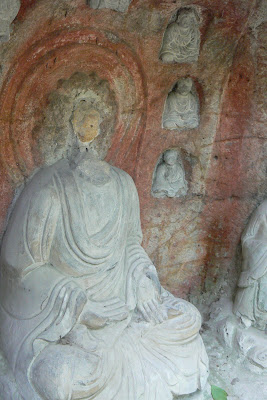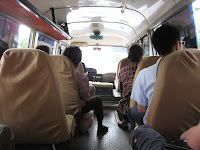
Nanjing is a couple hours from Shanghai - geographically it's in the center of China, but the name means "Southern Capital," historically it was the capital of a divided Southern China, fifteen hundred years ago. It was again a Ming Dynasty capital five hundred years ago, then a capital of the short-lived Taiping Rebellion one hundred forty years ago, and then the capital of the Republic of China, before and after the Japanese invasion.
I won't go into the historic details, I just listed what I did to show that it's an ancient, important city. When I visited, I didn't know what to expect, but perhaps a lesser Beijing or Seoul, which are filled with ancient temples and palaces. But I felt it was more similar to Shanghai - generally modern, with historic sites scattered about.
I had put off a visit because it's a five hour train ride, what a pain. However there's a new train service going to Nanjing, it looks something like a French LGV train and does the trip in only two hours. It's also a very comfortable ride, the downside being that it's $12 each way, whereas the slower, older trains start at $2.50 according to this
nifty if unfortunately Chinese-only train website. Travelling about Nanjing is also easy, there's a brand-new Subway system that goes straight from the train station to downtown.

A lot of the main sites to Nanjing revolve around its more recent history, and that includes memorials to the Nanking Massacre, Dr. Sun Yatsen's mausoleum, and the Taiping Rebellion. I wasn't quite feeling history when I went, so I either gave such places a miss or just had a cursory look. A lot of it is lost on me because I am still way more ignorant of Chinese history than I should be, and what I did see often wasn't very well presented for a clueless English-language tourist. Here's a small teahouse, located inside the re-constructed Taiping capital building - the reconstruction had its own history, as a government building of the Republic of China.

But the obvious highlight of the city is to the North-East of the downtown, with the Xuanwu Lake Park, and the adjacent Purple Mountain. Xuanwu Lake Park is reached by passing by the Jiming Temple (pictured at the top) and some scenic, gigantic, Ming Dynasty walls. These walls don't form a complete circle, but the large majority still exists, and surrounds a huge area of the downtown.

The park is a big lake, with a thin strip of land that meanders through it - it's nothing historic or amazing, but it's a pleasant walk - with a couple of caveats. First, the park is absurdly large, but when I went all the shops were closed, and there weren't any working water fountains, and I had been walking all day, and fell into some kind of panic mode. Secondly is, the pollution in the area is thick and disgusting, and combines with all the fog to make an impenetrable haze - there might have been great views, but it was hard to tell.


The pollution is more of a problem at Purple Mountain, where there's a half-hour ski-lift to the top of the mountain. It's a fun ride, but then when I go to the top I realized it was almost impossible to look back down at the city - I could also see that the nearby mountains held the pollution in. Another interesting perspective was the the very large city seemed to be built almost directly against thick mountain forests. Here's the best shot I got:

I've mentioned before that Shanghai is in the midst of a crazy building boom. Well that news is outdated. Shanghai still has a lot of building going on, including some extremely high-level projects. But it seems to have calmed down a bit, and there's no longer a new building going up on seemingly every single street. Whereas, going to Nanjing seemed to be like stepping into a time machine, and visiting this mythical quick-building Shanghai of 2005. These buildings generally looked a lot more bland and cheap than the buildings going up in Shanghai, though:

The downtown was the typical Chinese strip of brightly-lit shops and malls - which can be fun for a visitor, but I've gotten more than enough of that in Shanghai. More interesting was a long strip of restaurants and shops near Nanjing University. Four friends visiting from the US, and I, went to one place that looked nice - it served Nanjing cuisine. Everything was so cheap, I assumed the portions were small, and ordered to match. I came to realize that in truth, food in Nanjing is much cheaper than in Shanghai, and for less than $20, I ended up ordering a completely absurd amount, we ate less than half of it. This is just a part of the feast - note the roast duck heads up front! The food was excellent, the highlights being the country-style tofu and the pumpkin soup:

A little quirk on Nanjing is that even though I looked in a number of places, it was impossible to find Diet Coke - which would definitely be a major crimp on my lifestyle. I also never saw any Chinese beers except for the cheapest, lightest versions, the kind I wouldn't ever order in Shanghai. That was negated by running into the kind of bar I like: dark and dirty!

So while I can't say Nanjing is my favorite place in China, I definitely think it's worth a weekend trip, especially when factoring in the nearby Qixia Temple complex, which I'll talk about within the next week.
And for those in China dealing with blogspot and Wikipedia frequently being blocked and un-blocked for no apparent reason,
the Lost Laowai blog shows how to set Firefox to automatically get past the Great Firewall.
 Vegetable markets are very interesting, and yes my standards of excitement have been lowered by living in Shanghai for more than two years! But this market is more than that: who wouldn't be interested in markets selling live ducks, chickens, and pigeons! If nothing else, being in Asia and in close contact with poultry violates several US Government recommendations for citizens abroad - I like to live life on the edge.
Vegetable markets are very interesting, and yes my standards of excitement have been lowered by living in Shanghai for more than two years! But this market is more than that: who wouldn't be interested in markets selling live ducks, chickens, and pigeons! If nothing else, being in Asia and in close contact with poultry violates several US Government recommendations for citizens abroad - I like to live life on the edge.


 The vegetables sellers are side to side with each other, the streets are narrow and winding, second stories look like they're about to tip over the first story, and laundry is hanging everywhere. It gives the area a very cool, somewhat hectic feel to it. This is made even more so by the area it's in, the neighborhood is a very scenic collection of old style brick houses and winding alleys - the picture on the right is a of a nearby brick house of about the same era and style. For me it's a good opportunity to look around such a neighborhood without feeling like I'm trespassing private property! This picture is near the entrance where there's a little more room to maneuver. It all gets a lot tighter, farther into the market.
The vegetables sellers are side to side with each other, the streets are narrow and winding, second stories look like they're about to tip over the first story, and laundry is hanging everywhere. It gives the area a very cool, somewhat hectic feel to it. This is made even more so by the area it's in, the neighborhood is a very scenic collection of old style brick houses and winding alleys - the picture on the right is a of a nearby brick house of about the same era and style. For me it's a good opportunity to look around such a neighborhood without feeling like I'm trespassing private property! This picture is near the entrance where there's a little more room to maneuver. It all gets a lot tighter, farther into the market.

















































